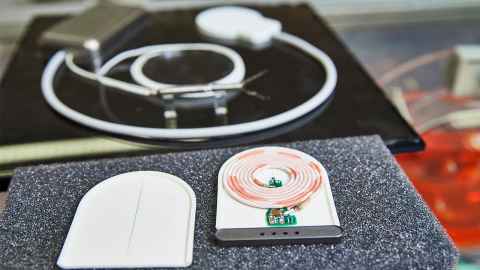Implantable Devices Group
Showcasing our research into implantable devices, their potential and how they can be used to make a dramatic difference to people’s lives.

Research questions
An electric heart pump can provide life support for heart failure. Today’s pumps need a wire poking through the skin to provide enough power to keep the pump spinning, and everyone gets infections from this wire.
The questions are:
- Can we do better?
- Can we eliminate drive-line infections using our wireless power transfer technology?
We have been looking at this and making developments at the University of Auckland over the past 25 years.
We have been working on a pump that can be charged overnight so it can run all day without cables and connections to support a patient’s natural heart. This work is in conjunction with leading clinicians and pump companies in NZ and the US.
Projects
Small, power-efficient implantable medical devices
The Implantable Devices Group has been developing small, power-efficient, wireless data acquisition systems that can be implanted for long-term monitoring of physiological signals.
A driving force has been our need to record sympathetic nerve activity which is small in magnitude, high in frequency content and measurement durations of a month are required.
Our solution to this problem is a compact device capable of recording a wide variety of biopotential signals with bandwidths as high as 8 KHz. These devices are now available through the Auckland-based company Kaha Sciences.
New sensors for blood analysis, blood flow and blood pressure monitoring
Our focus is on power and development of new sensors. Inductive power transfer has been used to provide energy to an ECG telemetry system for a rat. New sensors are being investigated for blood analysis, blood flow and blood pressure.
These devices are low cost, high volume, and have applications in diverse areas starting with the implantable animal monitoring market, moving into clinical monitoring and also adding versatility to other existing devices.
Optogenetics
This involves a custom-made implantable light module. Optogenetics uses light to manipulate neural activity. This has several advantages over conventional electrical stimulation approach including:
- Specific cell-type targeting with precise temporal precision
- Simultaneous stimulation using different wavelengths of light
- Eliminating side effects associated with electrical stimulation.
Optogenetic stimulation offers the potential of treating lifetime conditions such as Parkinson’s Disease. However, current optogenetics available commercially are mainly connected with wires or fibres existing the body and providing an infection risk and are generally not suitable for chronic use.
This study project is creating fully implantable optogenetics system supporting long-term light stimulation. A custom-made LED-fibre light module has been designed and validated to measure individual cellular response to optical stimulation of photosensitive rat brain slices.
Mitigating drift
Long term error accumulation of pressure readings (termed drift) significantly affects the operating lifetime of intracranial pressure monitors for hydrocephalus.
When drift occurs the real and measured pressures differ, which becomes clinically significant after some time.
Mitigating drift involves studying the contributions from raw pressure dies such as inelastic mechanical deformation and thermal effects of wire bonding. It also involves studying the effect of various encapsulation methods for water vapour transmission and moisture absorption, where encapsulation is required for biocompatibility and sensor protection.
Members
Primary contact
Academics
David Budgett
Beverly Chen
Robert Gallichan
Sarah-Jane Guild
Jenny Kruger
Simon Malpas
Dan McCormick
Professionals
Dario Barron
Laith Hermez
Stepan Lapshev
Alex Leung
Bryon Wright
Students
Cyril (Shun Long) Au
Emma Ordono Evangelista
Mehak Janjua
Rui Jin
Dixon Leung
Hendrick Lim
Alistair Newcombe
Laura Pedofsky
Reza (Mohammad) Seh Dehi
Chaoping Zhang
Funding partners
The Implantable Devices Group gratefully acknowledges the support of its funding partners:
- Auckland UniServices Ltd
- Pre-seed Accelerator Fund
- Health Research Council of New Zealand
- MBIE
- Hugo Charitable Trust
International links
- Australia: Baker IDI Heart and Diabetes Institute and Bionics Institute Melbourne
- US: Cedars-Sinai Cardiology and MIT, Boston